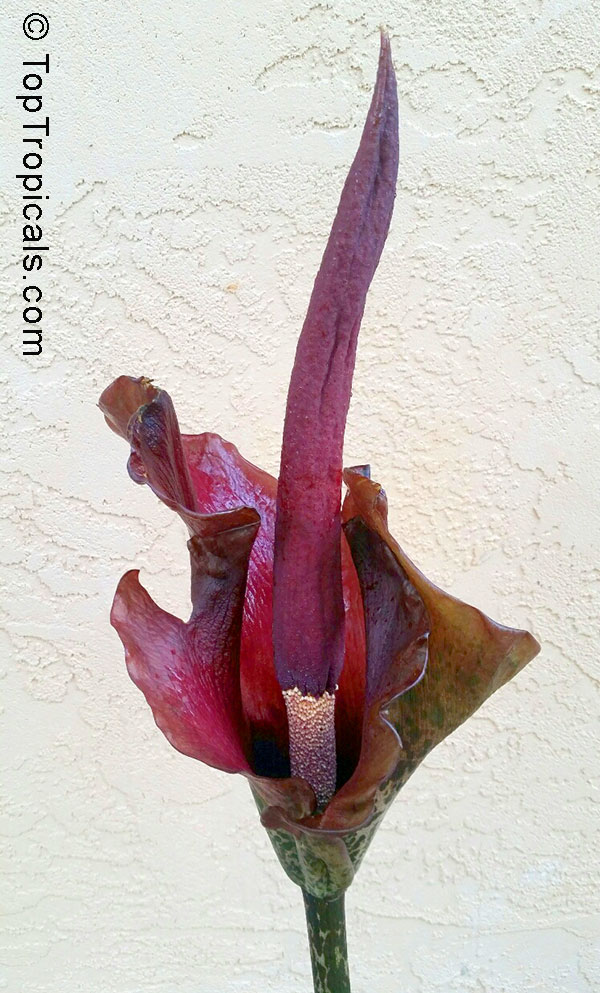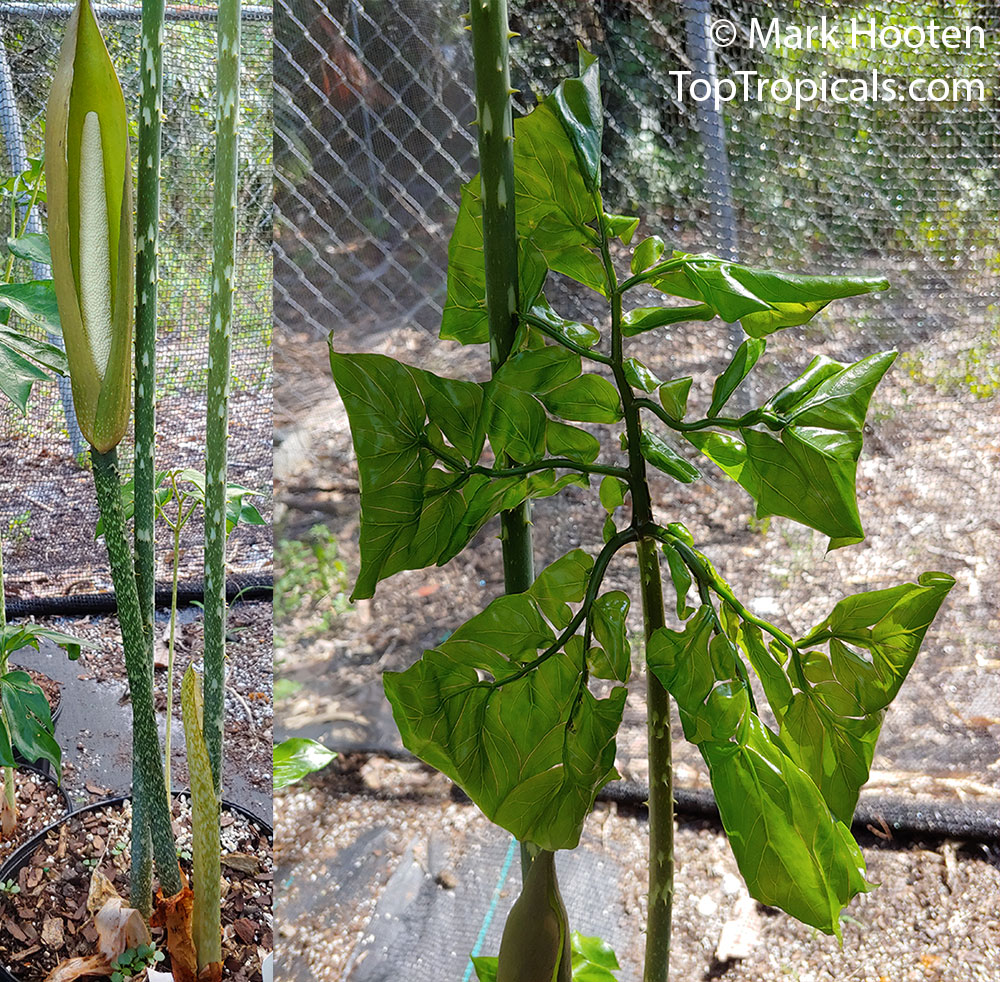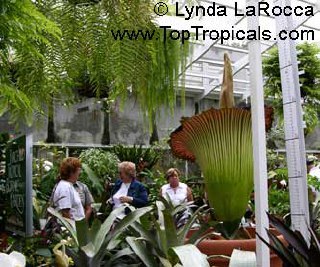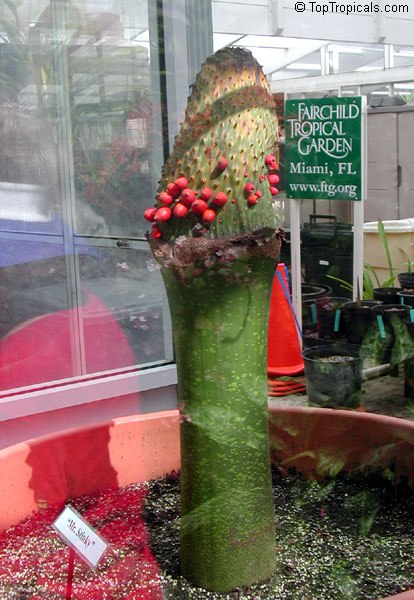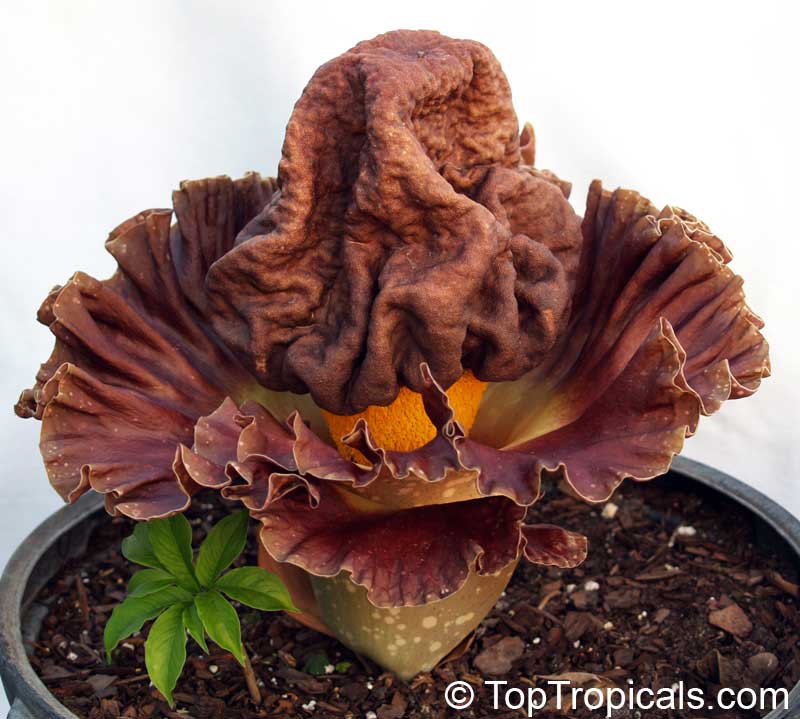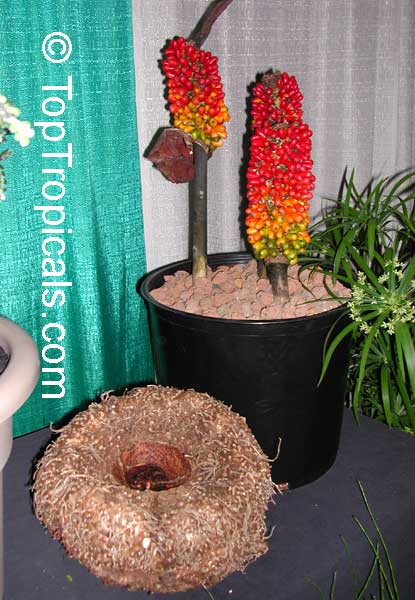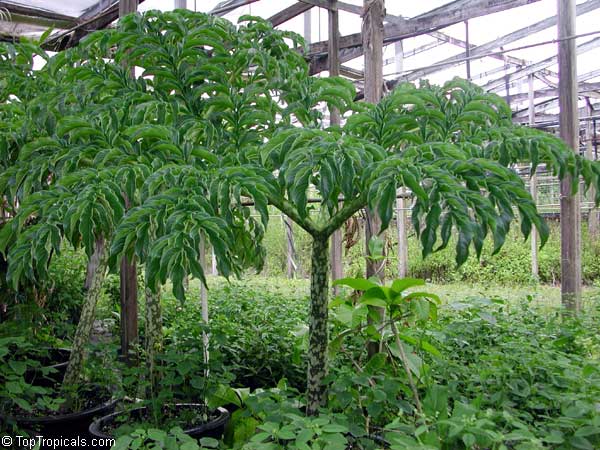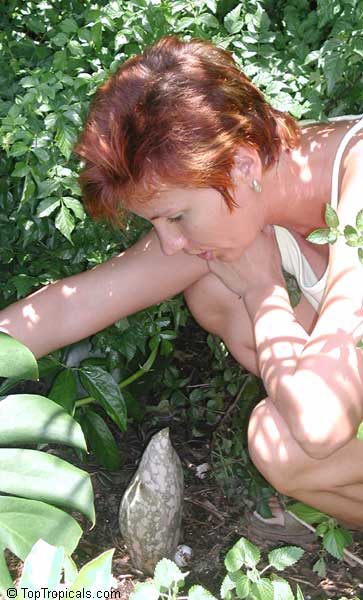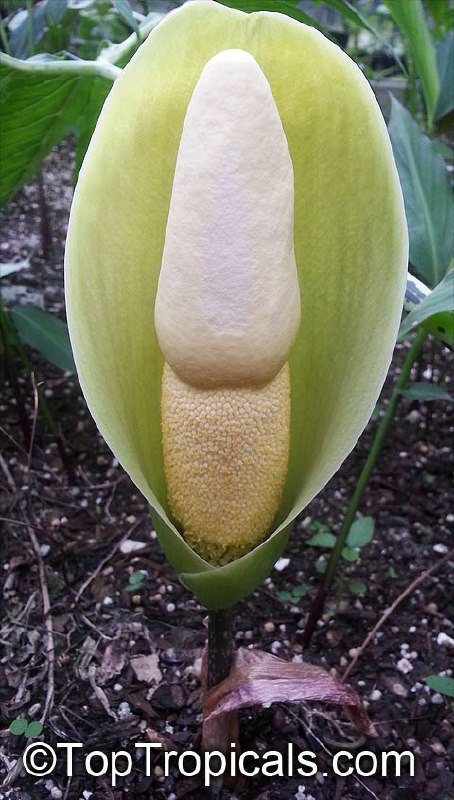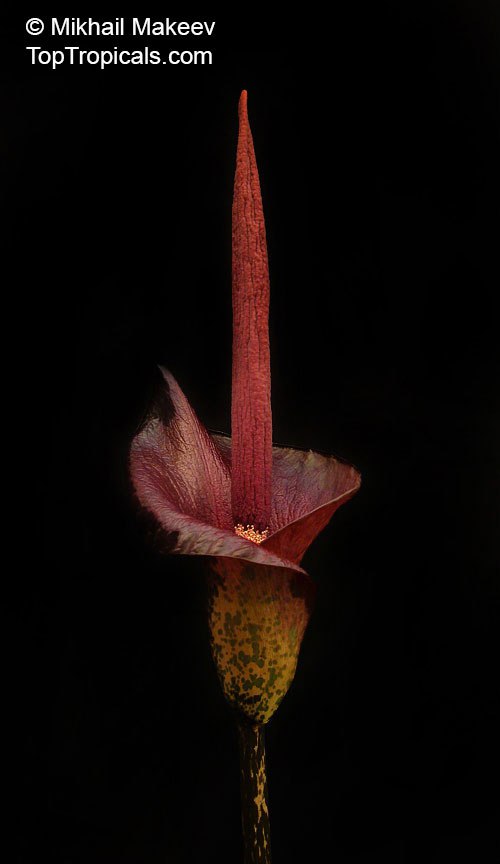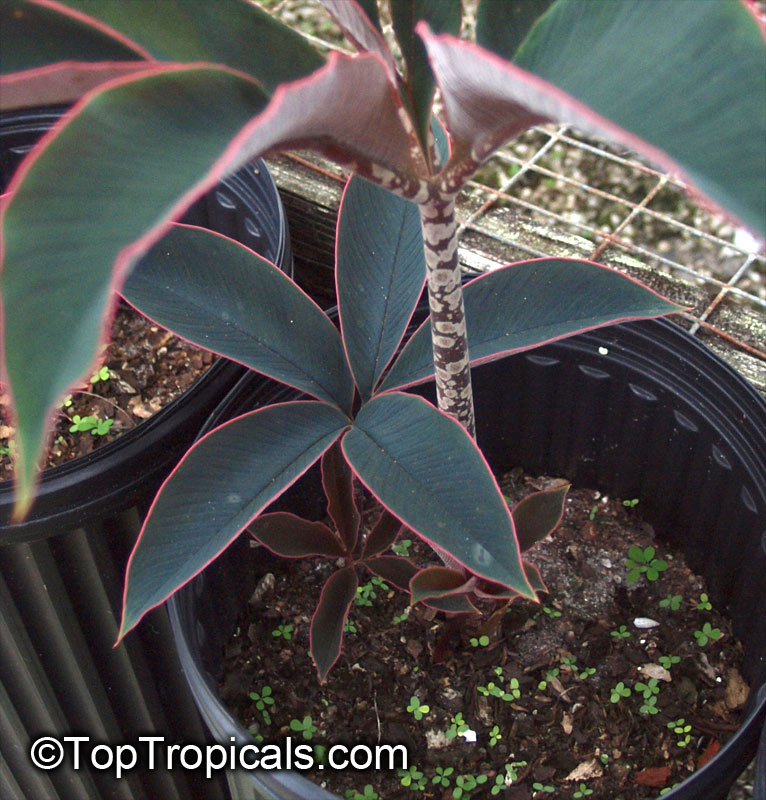Date: 1 Sep 2025
Whats inside the Devils Tongue that smells like trouble?
Amorphophallus paeoniifolius (campanulatus) - Voodoo lily
- 👹 Amorphophallus plants - the Voodoo Lilies - are also known as Devil's tongue, Snake Palm, or Elephant Foot Yam, Corpse flower. This plant has a reputation as wicked as its name!
- 👹 Amorphophallus is the largest flower in the world and one of the most exotic bizarre flowers. Amorphophallus titanum is known for its massive size, its flower can reach heights of over 10 feet and blooms only once every few years.
- 👹 Why Corpse flower? Because of the smell that the flower omits, but for only a few hours - just long enough to summon its pollinators, the flies 🐱
- 👹 The titan of the group, Amorphophallus titanum, can soar over 10 feet tall. But its cousin in this video, Amorphophallus paeoniifolius, is just as fascinating. It rises from a giant underground corm (which is actually edible in Asia), then sends up either one surreal flower or one umbrella-like leaf as big as a small tree.
- 👹 Season after season, it alternates between leaf and bloom, keeping its mysterious cycle alive. Hardy enough to rest through winter dormancy, it can even be grown in a pot at home.
After that, the air clears, leaving only the memory of the spectacle.
🎥 Amorphophallus paeoniifolius (campanulatus) - Voodoo lily
🛒 Discover more of Amorphophallus - rare and enigmatic plants
📚 Learn more:
#Nature_Wonders #Shade_Garden #Container_Garden
🟢 Join 👉 TopTropicals
Date: 7 Jun 2024
The biggest flower in the world - Amorphophallus
Amorphophallus bulbifer
After meeting Sausage Tree and Clitoria, are you ready for the Amorphophallus? Now you have seen everything!
- 💀 Common names of this exceptional plant: Voodoo lily, Devils tongue, Snake Palm, Elephant Foot Yam, Corpse flower.
- 💀 Why Corpse flower? Because of the smell that the flower omits, which is only present for a few hours after the flower opens - to attract pollinator flies!
- 💀 Amorphophallus is the largest flower in the world and one of the most exotic bizarre flowers. Amorphophallus titanum is known for its massive size, its flower can reach heights of over 10 feet and blooms only once every few years.
- 💀 This perennial exotic Asian plant grows a single, elongated center called a corm (that is actually edible) and a single large leaf that wraps around it.
- 💀 The seed stalk is very pretty with the seeds changing colors from green to red. During this time the tuber will not produce a leaf. After the flower and seed stalk dies away, a giant single leaf grows from the tuber.
- 💀 The single leaf dormant in winter, then in spring the plant shoots out this fantastic flower again.
- 💀 It is relatively cold hardy tropical and can survive cooler winters during dormancy.
- 💀 Can be easily grown in a pot as a houseplant.
🎥 Amorphophallus bulbifer and other specials in next post.
🛒 Shop Amorphophallus
#Nature_Wonders #Shade_Garden #Container_Garden
🏵 TopTropicals
Date: 28 Aug 2024
Fun Fact: Voodoo Lily

Amorphophallus konjak - Voodoo Lily plant
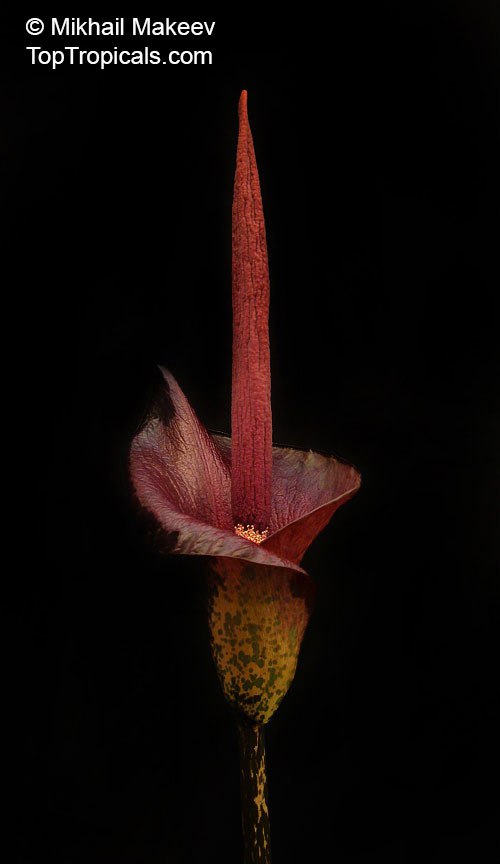
Amorphophallus konjak - Voodoo Lily, flower
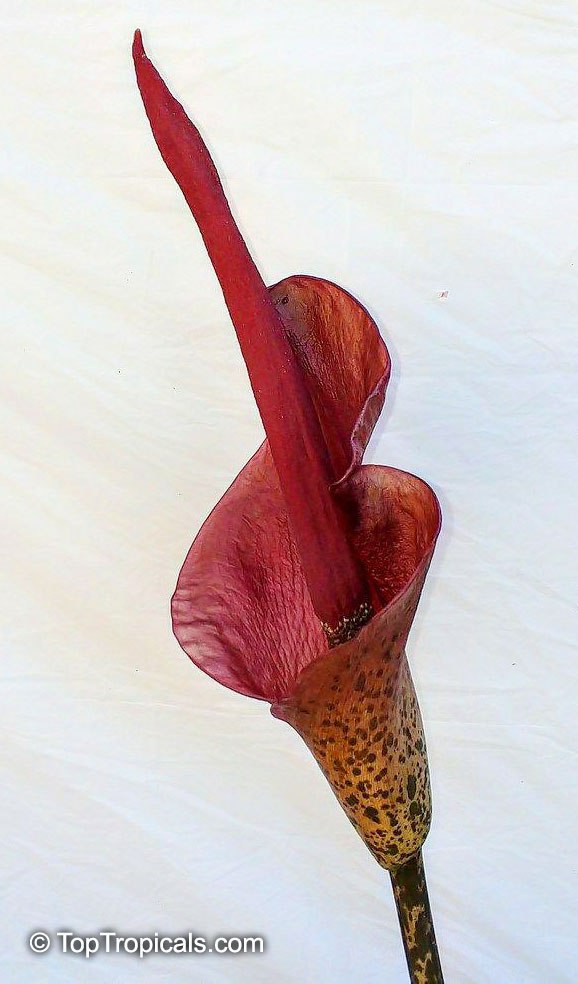
Amorphophallus konjak - Voodoo Lily, flower
👹 Amorphophallus konjak - Voodoo Lily, blooms from a single corm and releases an unforgettable scent, often compared to rotting meat. Despite its bizarre appearance and smell (that only lasts one day!), it's a showstopper that can easily be grown as a houseplant.
#Fun_Facts #Nature_Wonders #Container_Garden #Shade_Garden
🛒 Shop Amorphophallus
🔴 Join 👉 TopTropicals
Amorphophallus atroviridis
Family:Araceae
Voodoo Lily
Native to Thailand, Amorphophallus atroviridis is a small plant that typically grows to a height of 2-5 ft and prefers partial shade to semi-shade conditions. This plant has an ornamental foliage and blooms annually, displaying lovely pink or white/ off-white flowers.
This plant prefers regular to moderate water during its growth season but should be kept slightly dry during the winter months in colder regions. When it comes to plant care, it is best to grow this plant in a pot of average quality potting soil and water regularly. If you plan on cultivating this exotic plant in a cold region, it is best to bring the pot indoors during the cold season and keep it in a cool and well-ventilated place.
Amorphophallus atroviridis can be grown in USDA zones 9-11, and can be propagated by division or seed. To propagate by seed, it's best to sow the seeds in humus rich or seed starting mix and keep in warm and moist conditions for best results.
Overall, Amorphophallus atroviridis is a beautiful and unique plant that can bring a unique charm to any garden, balcony, or even a home. With beautiful pink or white/ off-white flowers and ornamental foliage, this easy to care for plant is sure to make a statement.
Amorphophallus bulbifer
Family:Araceae
Voodoo Lily
Amorphophallus bulbifer is one of the prettiest of the Voodoo Lilies and the inflorescence doesn't smell that bad compared to others of the genus. Amorphophallus only blooms when mature and even so it doesn't bloom every year. The unpleasant smell that the flower omits is only present for a few hours after the flower opens. If the flower is pollinated (normally by flies if the plant is outside) it... more
Close window
Amorphophallus konjac
Family:Araceae
Voodoo Lily
Amorphophallus konjac (Voodoo Lily) is a small plant growing 2 to 5 ft tall. Its flower has unusual color is white and purple. The flower is pollinated by flies that find its odor of rotting meat attractive.
It grows a single, elongated stem called a corm and a single large leaf that wraps around it. The corm is the part of the plant that is used, as well as its tuber, which is commonly called the Konnyaku potato. It is one of the most exotic, bizarre flowers. The single leaf dormant in winter, then in spring the plant shoots out a highly distinctive bloom. The tubers of the plant, Konnyaku potatoes, are edible when cooked like a potato and are often dried and ground into a flour used in noodles and tofu. It is also used in traditional ethnomedical practices. It can be grown in USDA Zone 8-11.
See detailed plant profile in new window: https://toptropicals.com/catalog/uid/amorphophallus_konjac.htm
Amorphophallus sp.
Family:Araceae
Voodoo lily, Devils tongue, Snake Palm, Corpse flower, Elephant Foot Yam
Amorphophallus species are herbs with an underground storage organ. This is usually a tuber. One single leaf emerges from the tuber, consisting of a vertical petiole (stalk) and a horizontal leaf-blade. The latter is dissected into few or numerous small leaflets. Once plants are mature an inflorescence may develop. The inflorescence may replace the leaf in one season, or develop alongside it. From... more
Amorphophallus konjac is one of the largest flowers, a perennial exotic Asian plant. It grows a single, elongated center called a corm and a single large leaf that wraps around it. The corm is the part of the plant that is used, as well as its tuber, which is commonly called the konnyaku potato. Amorphophallus konjac acts as a diet aid that has many benefits. Its ability to swell when mixed with water allows it to fill the stomach. It also moves through the digestive system very slowly, making the appetite feel satisfied for a longer period of time. This characteristic of Amorphophallus konjac is beneficial in treating obesity. It is one of the most exotic, bizarre flowers. Can be easily grown in a pot as a house plant. The single leaf dormant in winter, then in spring the plant shoots out a remarkable flower.
Close window
Amorphophallus symonianus
Family:Araceae
Voodoo Lily
Amorphophallus symonianus, also known as the Voodoo Lily, is a small shrub native to Thailand. Its petioles can reach a height of 2 to 5 feet, with an olive-green speckled color. On top of the petioles is a green leaf at the bottom and a white off-white perianth at the top. Although the color may appear to be plain, the way in which the flower is arranged makes it quite an unusual sight.
When it comes to growing and caring for a Voodoo Lily, it can be done relatively easily with the right conditions and maintenance. It should be grown in USDA Zones 9-11, in an area with partial shade or semi-shade, and away from direct sunlight. Regular watering is also needed, though not too often as to cause root rot. The soil should be kept moist with moderate water, so as to provide ideal growth conditions.
For those living in colder regions and wanting to potentially cultivate their own Voodoo Lily, you can do this with ease in a pot. As long as it is placed in a warm and moderately light environment, then the plant should develop and thrive. Be sure to avoid direct sunlight and keep the plant in some shade instead. Additionally, it is important to water the plant regularly and provide it with a well-draining soil and enough nutrients to keep it healthy.
Overall, the Amorphophallus symonianus makes an interesting addition to any garden or potted setting and brightens up any space with its unique arrangement and beautiful off-white flowers. Although it requires the right level of care and maintenance, the Voodoo Lily can add life to any environment, be it fully outdoor or an indoor potted plant.
See detailed plant profile in new window: https://toptropicals.com/catalog/uid/amorphophallus_symonianus.htm
Amorphophallus titanum
Family:Araceae
Titan Arum
Titan Arum (Amorphophallus titanum), native to Sumatra, is a large plant that can reach a height of between 5-10 feet. It features an unusual color palette single flower of deep green on the outside, and dark burgundy red on the inside when in bloom. Its flowers have a vinous color, and the deeply furrowed texture adds to its uniqueness. After the flower dies back, a single leaf, which reaches the size of a small tree, grows from the underground corm.
This flowering plant is best grown in USDA Zones 9-11, although it can be grown in other zones with the right care. The best location for this plant is in the shade or in semi-shade, away from direct sunlight. Titan Arum plants should have regular access to water, although they don't tolerate a lot and too much water can lead to root rot. Moderate watering is the best way to ensure healthy growth and development.
When grown in a pot in colder climates, it is important to ensure the soil is well-draining. Winter dormancy is usually not necessary for these plants, but if temperatures do drop, the plant should be protected from any frost. It is also important to note that these plants need to be kept away from direct sunlight during summer, otherwise it may lead to burn.
Titan Arum makes for an excellent addition for your garden due to its exotic and unique looks. With the right care and maintenance, this plant can thrive and can provide a great statement piece.
Anchomanes difformis, Amorphophallus difformis
Family:Araceae
Anchomanes
This is the most unusual aroid, distantly related to Amorphophallus. Growing from a horizontal tuber that can measure up to 30" long by 10" across, the plant produces one huge, much-divided leaf with a stout prickly stem.
Originated from the jungles of Benin, along the west coast of Africa. The indigenous people there use the species for a variety of medicinal properties.
These unusual plants grow from a thick, slowly growing tuber, often branching, which creeps horizontally just below the soil surface. The compound leaves are up to 30 inches tall and are supported on slender spotted stems with very rose-like thorns. The fascinating leaves are an enlogated bi-lobed bat shape, often with fenestrations (window holes).
Dormant all winter when they should be kept cooler but not cold, and the soil only occasionally lightly watered until spring. Upon warming weather, they should receive abundant water and bright light, but with no strong sunlight, as this is a jungle species. Often, but not every year, they begin growth with a tall, slender flower spike which may or may not self-pollinate and eventually produce a cluster of white berries which eventually turn voilet-purple when ripe and ready for planting. Germination takes several months, usually in spring of the following year. In Florida, they need only to be planted in the ground, and can then pretty much take care of themselves, although they grow equally well in pots. When in active growth, they want abundant water.
Detailed plant profiles: 11 plants found
